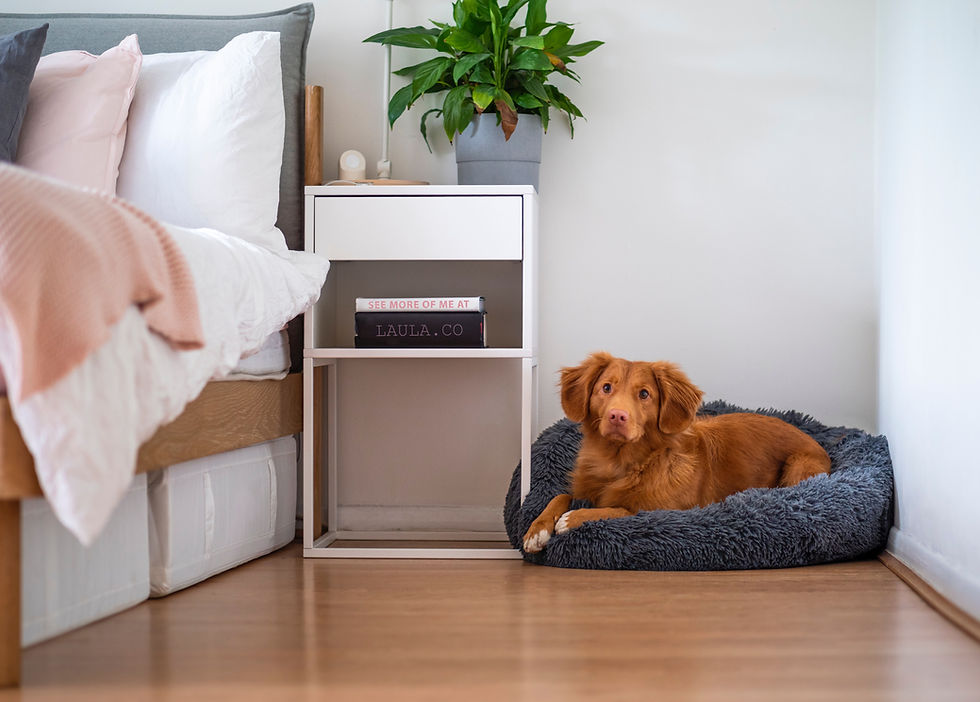Creating a Tranquil Transition: Strategies for Successfully Welcoming a New Pet
- kharrison1010
- Jul 19
- 3 min read
Updated: Jul 20
Bringing a New Pet Home: A Guide for a Smooth Transition
Bringing a new pet into your home is an exciting adventure—but it can also come with challenges for both your family and your furry friend. Preparing in advance can make all the difference. This guide offers trusted strategies to help you create a loving, peaceful environment and set your new pet up for success.
Understand Your New Pet's Needs
Every pet has unique needs and
understanding them early helps create a smoother adjustment period.
Dogs often need 30 to 60 minutes of daily exercise and thrive on social interaction. That said, it's important to provide a quiet, cozy space where they can rest and decompress.
Cats enjoy short bursts of interactive play throughout the day, paired with lots of downtime. In the first few days or weeks, a quiet area away from household traffic helps them feel secure as they adjust.
Consider your pet’s age, breed, background, and personality to guide your care. Taking the time to learn about their needs shows you care—and helps lay the foundation for a strong bond.

Create a Safe Space
Setting up a designated area just for your new pet can greatly reduce anxiety during the transition.
Dogs may feel comforted by a crate or quiet area with familiar scents—like a cozy blanket or an old t-shirt that smells like you.
Cats often prefer high perches or enclosed nooks where they can observe and relax. A secluded room away from other pets or children can offer a needed retreat.
This safe haven will help your pet feel secure and protected in their new environment.
Introduce Family Members Gradually
Give your new pet time to explore and settle before introducing them to everyone at once.
Once they seem more comfortable—often after a few hours or a day—begin introducing family members one at a time. Keep interactions calm and positive, using treats or gentle praise to encourage bonding. If children are involved, supervise all interactions closely to ensure safety and promote respectful behavior on both sides.
Set Boundaries Early
Clear household rules help reduce confusion and build trust.
Decide in advance what’s allowed and what’s not—like whether pets are allowed on furniture, where they’ll eat and sleep, and which areas are off-limits. Make sure the entire family stays consistent with expectations. Structure and routine create a sense of safety, which helps pets settle in with greater ease.
Prioritize Training and Socialization
Training plays a major role in helping your new pet integrate into your home.
Start with basic commands like “sit,” “stay,” and “come.” For dogs, enrolling in a training class can accelerate progress and prevent future issues. Use positive reinforcement—like treats and praise—to build trust and encourage desired behaviors.
Socialization is just as important. Gradually exposing your pet to new people, pets, and environments builds confidence and improves behavior.
Support Their Health and Nutrition
A healthy pet is a happy pet.
Work with your veterinarian to select the best diet for your pet’s age, size, and lifestyle. Feed on a regular schedule and monitor for signs of sensitivity or dietary needs. Make preventive care a priority: routine vet visits, vaccines, and parasite prevention should begin as soon as your new pet arrives.
Introducing a New Pet to Existing Pets
If you already have pets, introduce them gradually and carefully.
Start with scent exchanges and supervised, distanced meetings. Watch for body language cues—overexcitement, fear, or aggression—and be ready to pause if needed. Give both pets individual attention and try to maintain their usual routines. Proper introductions can take days or even weeks, so be patient and seek professional guidance if challenges arise.
Offer Daily Enrichment
Mental and physical stimulation is vital for your pet’s overall well-being.
Rotate toys, use puzzle feeders, or set up short play sessions throughout the day. Shared family activities, like walks or tug-of-war, build connection and help your pet burn energy in positive ways.
Observe and Adapt
Pay attention to your pet’s body language and behavior as they adjust.
Signs like hiding, excessive vocalization, or changes in appetite can signal stress. Adjustment periods vary—some pets settle in hours, others take weeks. Be patient, observant, and responsive to their needs along the way.
Your Path to a Happy Home
Welcoming a new pet is a joyful and rewarding experience. With thoughtful preparation, gentle guidance, and lots of love, you can create a safe and supportive home where your pet can thrive.
Embrace the journey—it’s the beginning of a lifelong friendship.




Comments